Introduction to SAP APO TM
Executive Summary
- An Explanation and Introduction to TM
- Basic Functionality and Concepts of SAP TM
- High-Level Processes
- Shipment Creation
- Carrier Tendering and Selection
- Carrier Selection
- Carrier Cost Estimation
- Transportation Load Builder
- Important SAP TM Structures
- Transportation Lanes
- Location Geo-coding
- Transportation Modes
- Transportation Zones
- SAP TM Resources
- Vehicle Resources
- Freight Units
- SAP Event Management
- SAP TM Release History

Introduction
In this article, you’ll get a high-level overview of the entire SAP APO TM.
Transportation planning is the business function of planning your company’s transportation in a way that meets quantity movements and time objectives at a reasonable cost. Transportation tends to be separated from the other supply chain planning functions, but it really shouldn’t be. And with integrated planning systems such as SAP SCM, you can keep all planning functions together, including transportation planning, to be more tightly connected and integrated. As with PP/DS, which combines production planning with detailed scheduling, SAP Transportation Management (SAP TM) is also separated into two distinct functionality areas. While typically considered for use in planning outbound shipments, SAP TM is also used to plan inbound shipments and inter-facility shipments. Transportation planning is the smaller section of the application and covers transportation forecasting, strategic transportation management, and the assignment of individual deliveries to aggregated shipments. Vehicle scheduling is also focused on sequencing the deliveries and mode, carrier, and vehicle resource selection.
History of TM
SAP TM is one of the early SAP SCM applications, but it is installed less frequently than the more popular applications such as DP, SNP, and PP/DS. This may have something to do with how ancillary transportation is often viewed to the business compared to demand or supply planning. But what is often missed in this view is the interconnection of all of the supply chain functions. Because transportation planning is not only important in terms of improving transportation management specifically, and in obtaining good transportation rates, but also in terms of supporting goals such as inventory management, retail in-stock position, and even production efficiency. Also, trends such as increasing energy prices and smaller buffer inventories make transportation management more important than ever. A 100% SAP solution implementation would look like Figure 7.1, and the most common form of integration will be SAP TM to SAP ERP. But SAP TM could integrate into non-SAP ERP systems.
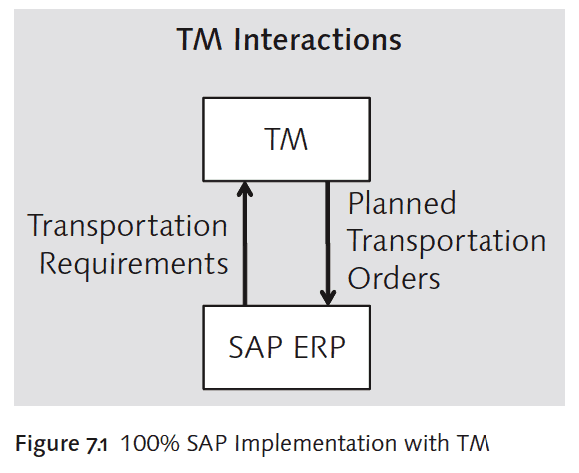
Let’s look at the general functionality offered in SAP TM and determine how it can benefit your company.
Basic Functionality and Concepts of SAP TM
SAP TM is designed to plan and schedule freight and vehicles moving across a supply network at the lowest cost while meeting the transportation needs in quantity and time based on specific requirements. You can use SAP TM to perform the actual vehicle scheduling, which is necessary if your company actually owns the transportation equipment or can use it to manage hired carriers if you outsource transportation.
High-Level Processes
It’s easy to underestimate transportation planning’s complexity unless you have firsthand experience working in the area. But even then, there are many steps to the overall transportation management process. In SAP TM, the processes are broken down into the following high-levels:
- ››Strategic freight management
- ››Transportation forecasting
- ››Freight order taking
- ››Transportation planning and execution
- ››Freight tracking and tendering
- ››Freight settlement and analysis Within these larger overall processes, there are also specific processes that SAP TM has been designed to handle. Specific Processes There are many specific processes within SAP TM, but some of the most prominent are listed here:
- ››Shipment creation
- ››Carrier tendering and selection
- ››Contract management
- ››Vehicle scheduling
- ››Carrier cost estimation
- ››Transportation load building
Understanding these processes is important to understanding the scope of what SAP TM does, so let’s look at each of these a little closer.
Shipment Creation
There are different ways of creating a shipment in SAP TM, including the following methods:
- ››From the create a shipment function
- ››From a planning proposal
- ››From the collective processing run: The creation of shipment function is a manual process, while the planning proposal creates shipments according to preset profiles. The collective processing run is a method of creating shipments in batch. It creates shipments automatically and can be scheduled. SAP TM uses the following documents to create shipments:
- ››Sales orders
- ››Purchase orders
- ››Stock transport orders
The sales order moves material to customer locations. The purchase order initiates a movement inbound to the company from a supplier. The stock transport order initiates a movement between company locations, most often between warehouses.
Carrier Tendering and Selection
Carrier tendering is the shipper’s process of putting freight out to bid and receiving confirmation on prospective freight movements from carriers. It’s a form of collaborative transportation planning. This ordinarily is a very labor-intensive process if you don’t use a system of some type to manage the process. The ultimate goal is to set freight out to bid automatically and have the system select the best alternative from the returned responses. According to SAP Help, “the accepted quote contains the updated terms and conditions of the transportation service and the TSP that carries out the transportation service.”
Carrier Selection
SAP TM provides carrier selection functionality based on the lowest cost. However, SAP TM can also make carrier decisions with consideration for service standards. SAP TM performs this task by maintaining the history of each of your carriers’ performance. SAP TM can then use this information to make better decisions in the future regarding carrier selection. Also, direct freight cost is one of the many costs associated with transportation that can be tracked. Using the service level selection functionality gives you a more comprehensive view of transportation activities. Contract Management Contract management allows the system to accurately maintain a list of the transportation companies under contract in a centralized database and incorporate updated rates. It also allows you to compare and contrast carriers and then adjust contracts based on this information. This functionality can have strategic decision-making implications because it records the cost to service various regions, allowing you to determine if some areas should be outsourced to another transportation provider or simply dropped from service.
To use capabilities such as contract management, the logistics department must actually have time to perform analysis. But too many logistics departments are caught in the trap of lacking the skills, budget, or systems to perform longer-term analysis.
Vehicle Scheduling Within SAP TM, vehicle scheduling is where most heavy lifting or at least a lot of the interesting functionality is contained. The following are some examples:
- ››Optimization, which uses various costs related to transportation, delivery inside and outside of location windows, loading costs, wait time costs, and other costs associated with the transportation movement to arrive at optimal routing. Optimal routing is simply the best sequence of location combinations resulting in the lowest costs while meeting all constraints and requirements.
- ››Selecting among multiple modes
- ››Selecting carriers (tactically)
- ››Selecting vehicle resources You can run SAP TM in two ways. You can use the optimizer, or you can perform a manual assignment of demand for vehicle resources. Vehicle scheduling, when employing the optimizer, also uses constraints to arrive at a feasible result. Constraints on vehicle scheduling include the following:
- ››Delivery windows
- ››Vehicle capacity
- ››Depot location
- ››Vehicle incompatibility
- ››Schedules of vehicle types
- ››Handling resources
- ››Opening hours of locations
- ››Maximum storage time at the location
- ››Limits on distance, duration, and stopover
Carrier Cost Estimation
This functionality allows a cost function to be produced for every transportation movement, for each to be compared against alternatives, and for the best or lowest cost alternative to be selected. For instance, one alternative may have a cost structure that looks like this:
- $25 per mile per 1000 units
- $150 per stopover For a transport of 2000 units over 100 miles with two stopovers, the cost would be $5600. After these values are placed into SAP TM, the software can perform the calculation iteratively and automatically.
However, this is a simplified example because SAP TM can incorporate many different costs. If you really want to understand what’s happening in the optimizer, you need to consider the following:
- All of these costs are calculated automatically for hundreds or thousands of alternatives.
- The lowest cost alternative for each shipment is selected.
This gives you a good appreciation for the work the SAP TM Optimizer is performing.
The optimizer issues are similar to those for the SNP and PP/DS optimizers, which comes down to quantification of costs, inputting these costs, and then allowing the optimizer to run.
Transportation Load Builder
The transportation load builder (TLB) optimizes transportation assets by reconfiguring the load to use the internal container space efficiently. There is actually a 3D solver at work behind TLB. But TLB doesn’t have to be part of your initial SAP TM implementation and can be separated due to its highly specialized nature.
Yard management manages the flow of vehicles that pick up and deliver material to the warehouse. The parking area for the trucks is where the trucks are staged. In a 100% SAP SCM solution, this isn’t controlled by SAP TM but rather by SAP Extended Warehouse Management (SAP EWM). However, SAP TM does affect yard management by placing SAP EWM in a better position to manage the yard by adhering to the delivery windows set by facilities. These windows can be either soft or hard constraints for SAP TM. See Chapter 11, SAP Extended Warehouse Management (SAP EWM) to read more about yard management.
This concludes our review of the specific processes in SAP TM, and hopefully, you’ve seen how effective they can be for your own business. Now let’s move on to discuss the important SAP TM structures that need to be configured.
Important SAP TM Structures
Some of the more important areas of SAP TM that must be set up include the following:
- ››Transportation lanes
- ››Transportation modes
- ››Transportation zones
- ››Transportation resources
- ››Freight units
As with the specific processes, let’s look at each of these to help you understand SAP TM’s high-level design.
Transportation Lanes
As mentioned in Chapters 1 and 4, a transportation lane is a route between two locations. Transportation lanes are prominently used in the SNP application, and SPP and GATP also use them. Different lanes can have different means of transport assigned to them. For instance, a transportation lane from Long Beach to Antwerp could have an ocean carrier or air transport lane assigned to it, while a transportation lane from Long Beach to Phoenix could be assigned an air transport, rail, or truck lane. Also, a supply network is made up of transportation lanes and locations. Transportation lanes set the legitimate material movement routes through the supply chain (Figure 7.2).
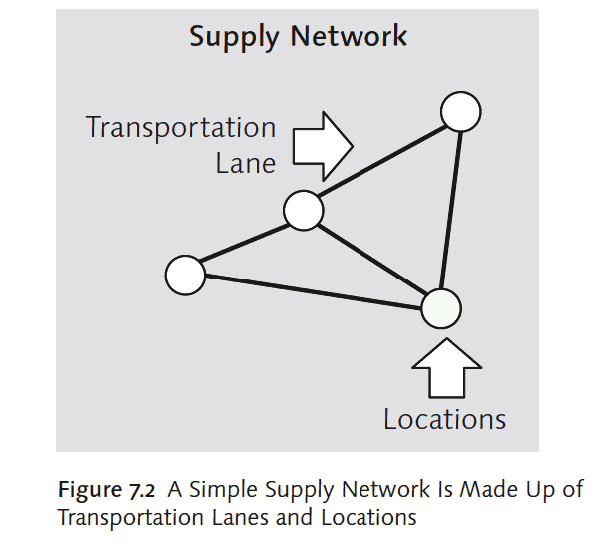
SAP TM simply plans the material movements that have been communicated to it by another application or system. However, the transportation lead times and costs used by SAP TM to plan transportation also affect decision-making in other SAP SCM areas. Usually, in the supply network, in most cases, the movements between different locations are not restricted explicitly; however, there is an exception to this rule. The SPP application restricts some of these location combinations to improve system performance (although inventory rebalancing in SPP removes these restrictions). You can read more about this in Chapter 10, SAP Service Parts Planning (SPP).
Transportation lanes are automatically created in SAP SCM when purchasing info records, and scheduling agreements are brought over from SAP ERP. However, they don’t exist as transportation lanes in SAP ERP and only become transportation lanes when incorporated into SAP SCM. In addition to coming in through CIF, transportation lanes can be created within SAP SCM manually. This allows lanes to be added quickly and is especially useful when making small changes after the initial model has been created.
Location Geo-coding
SAP TM provides significantly more accuracy to locations and, by extension, to transportation lanes through geo-coding. Geo-coding is the assigning of longitude and latitudes values to locations. SAP TM can automatically determine the distance between locations to a precise detail level if they are geo-coded. Geo-coding can be entered using the location master on the General tab (Figure 7.3) or using the Mass Maintenance transaction.
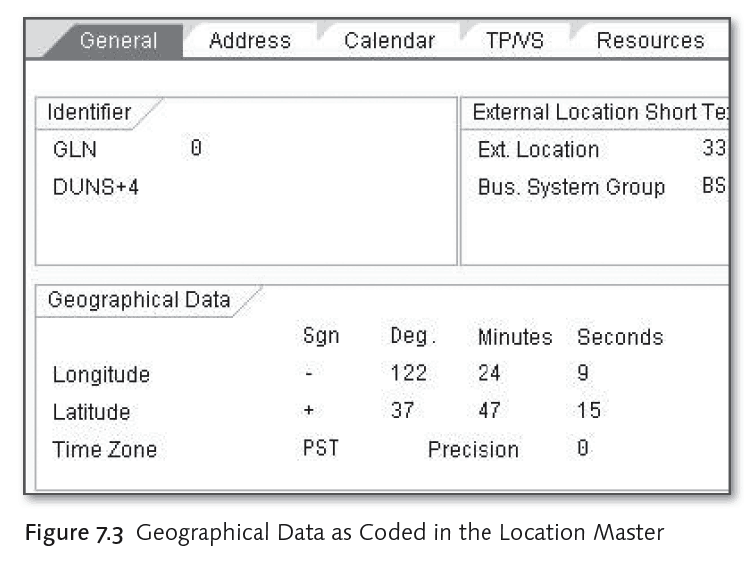
Also, transportation lanes can be created within SAP SCM either manually and one by one (Figure 7.4) or in a batch using the Mass Creation of Transportation Lanes transaction (Figure 7.5).
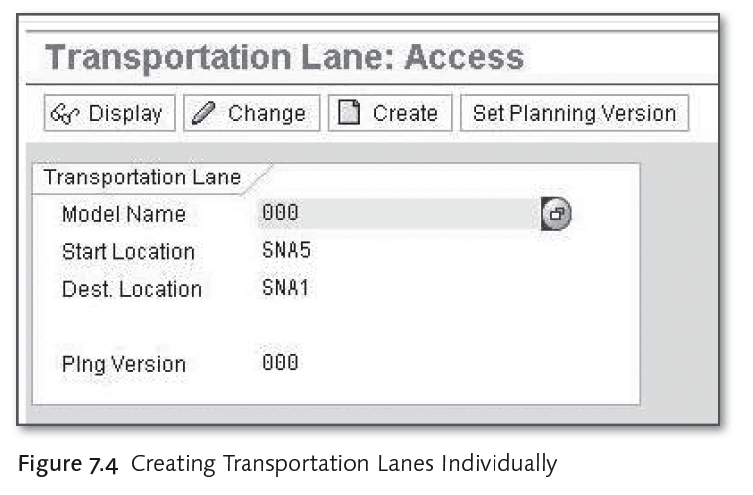
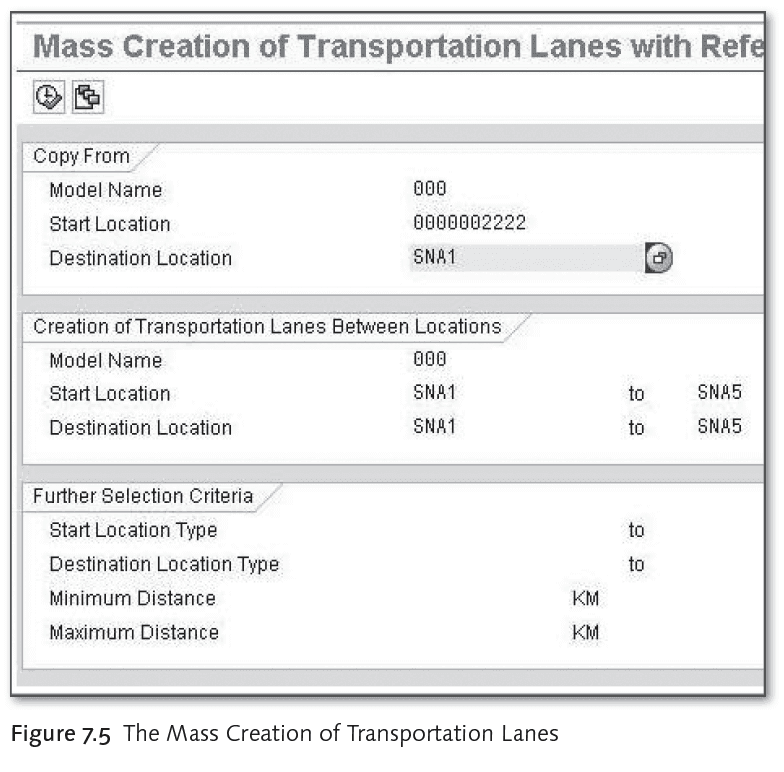
While transportation lanes control the flow of material in the supply network, they also have several configuration data elements associated with them:
- ››Product procurement parameters such as validity dates, shipment lot sizes, and priorities
- ››Controls such as transportation calendars, distances, and duration
- ››Carrier capacities
This is another way you can constrain the actual transportation lane that applies to all vehicles that use that route. And because it allows the constraints to be set on the lane rather or in addition to any constraints placed on the vehicles, it’s an added way to control the flow of material consistent with company objectives. You can configure these data elements in the location master, as shown in Figure 7.6.

The Location Master has its own TM tab, which allows the entry of values for things like the Transportation Zone. This applies to the location as well as the amount of time goods can wait at the location.
Transportation Modes
SAP TM is most often used for managing truck fleets. However, less often implemented is the use of SAP TM for planning and scheduling rail, air, and ocean transportation. By simply adding the mode alternatives into the vehicle scheduling profile, SAP TM can make decisions between both modes and specific carriers as part of its normal run. However, because far fewer shippers own private fleets outside of trucking, it’s more appealing to transportation companies in these different modes.
Transportation Zones
One of the most important parts of master data for SAP TM is the transportation zone. Transportation zones are created from the following SAP ERP master data:
- ››Plants
- ››Customers
- ››Suppliers/vendors
- ››Transportation lanes
- ››Scheduling agreements
You can use these transportation zones to assign multiple locations to a single zone so that all locations are served with one transportation lane. This allows you to reduce the number of transportation lanes that must be processed. And in addition to its general use in planning to reduce the complexity of the transportation solution to be solved, the transportation zone is also used in TLB. Transportation Groups Transportation groups are used to categorize materials to define shipments for specific transportation types to be scheduled. It’s based on the reality that many products have unique transportation needs. A common transportation group category is refrigeration. And as you probably know, refrigerated items can only be transported on vehicle units with refrigerated containers. By using transportation groups, SAP TM ensures that refrigerated freight is only assigned to refrigerated vehicles. Other examples of transportation groups include hazardous goods and chemicals. While SAP TM ships with several standard transportation groups, you also can access an unlimited number of transportation groups that you can create manually.
SAP TM Resources
Along with SNP, PP/DS, and SAP EWM, SAP TM uses resources for planning. Both SNP and SAP TM deal in resources that transport material; however, they are called transportation resources for SNP, while for SAP TM, they are called vehicle resources. Vehicle resources can be both different modes and subcategories within a mode (Figure 7.7). For instance, less than truckload (LTL) is a subcategory within the trucking mode. And as with other resources, these are given a capacity and are scheduled. All of the resources have many uses; for example, the setting of average speed for a vehicle allows SAP TM to forecast how long transit will take.
You might wonder whether resources are used for outsourced transportation. But the most logical option is actually the tendering functionality that can be used to obtain commitments on loads and routes. Tendering refers freight being put out to bid by shippers and being accepted by carriers. A company can model an outsourced carrier’s capacity with resources but only with significantly added complexity. It would also require that the carrier update the company frequently with its capacity or at least the segment of its capacity allocated to the shipper.
Where resources are assigned realistic capacities, the resulting plan is considered feasible. However, transportation plans that don’t use capacity-constrained resources are considered “infinite,” a technical term in operations research for unbounded or unrealistic. SAP TM resources are designed to represent loading and transportation capacity. The following are resources that apply to SAP TM:
- ››Vehicle resources
- ››Handling resources

Vehicle resources are specific to SAP TM, and the means of transportation are extremely varied. Also, all of the SAP SCM resources are enormously flexible in terms of what can be set as a constraint.
Vehicle Resources
In all of SAP SCM, vehicle resources are only used in SAP TM. They are set in terms of capacity per unit or per unit of time. By constraining these resources and then applying the projected volumes, SAP TM calculates how many different unit load types are necessary to meet the plan. The vehicle resource capacity is flexible and can be stated in pallets or cubic feet, among many other units of measure. This can allow the system to use the unit of measure that is the actual constraint. For example, on light but high-volume material, the cubic feet unit of measure can be used. For heavy freight, a weight unit of measure can be applied. Transportation Versus Vehicle Resources SNP can also be involved in transportation planning through the use of transportation resources. SNP transportation resources can hold roughly the same amount of data and constraints as a vehicle resource. Transportation resources are assigned to the transport mode in the transport lane and used by either CTM or SNP. The processes supported include the following:
- ››Outbound delivery
- ››Delivery
- ››Stock transfer
- ››Cross docking
- ››Returns
You can see the resource configuration of the SNP Bucket Cap. Tab in Figure 7.8.
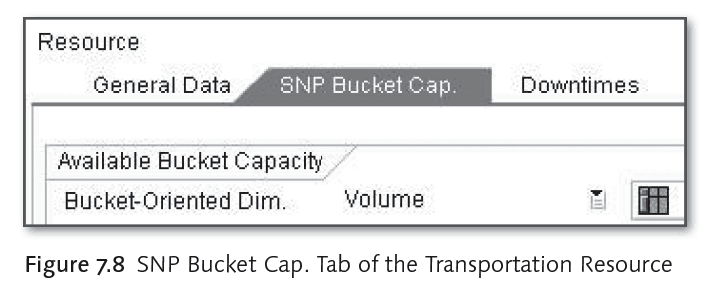
Transportation and vehicle resources share many similarities, but resources are used for vehicle scheduling in SAP TM, whereas transportation resources are only used for higher level planning in SNP. Let’s wrap up our review of the resources in SAP TM with a look at freight units.
Freight Units
Much like the SAP EWM handling units, SAP TM uses freight units to control the material to be moved. After consolidation, the freight units are loaded into the vehicle resource. The process of consolidation organizes the following into freight units:
- ››Order items
- ››Delivery items
- ››Order schedule items
This consolidation can occur interactively, which gives you a high degree of manual control, or it can occur in the background. One final thing to consider about SAP TM is integration with other applications, particularly SAP Event Management (SAP EM). Integration to
SAP Event Management
In the next chapter on SAP Event Management (SAP EM), SAP EM can accept data from many sources, which is how it provides an integrated view of the supply chain to the company implementing the software and selecting partners alike. SAP EM is a combination of a monitoring frontend and an integration component. It can receive data from the following different categories of sources, which, when combined, provide a comprehensive view of the supply chain:
- ››Transportation providers
- ››GPS
- ››Scanners (both facility and vehicle based)
- ››Vehicle computers
- ››Suppliers
- ››RF devices
Note that most of the listed areas are related to either warehousing or transportation, and in a 100% SAP SCM solution, including SAP EWM and SAP TM. However, SAP EM is most often used in conjunction with transportation (either to SAP TM or connected to another carrier-based system, receiving documents such as ASNs). This is because transportation is often outsourced, even more often than warehousing, and the planning system needs a way of knowing the location of freight in motion. This concludes our look at the functionality of SAP TM, so let’s take a brief look at what was added in the newest release.
SAP TM Release History
SAP TM is one of the older applications within SAP SCM. However, it has still seen some significant improvements as of SAP SCM 7.0:
- ››Enhanced ability to add users with different roles. Roles include the following:
- –– Transportation Booking Agent
- –– Transportation Charge Clerk
- –– Transportation Dispatcher
- –– Transportation Manager
- –– Transportation Network Admin
- ››Simplified Create Shipment Requests screens. These are targeted at mid-sized firms. ››Enhanced planning interface allows for defining loading and unloading sequences, replacing resources, changing destinations and locations, and displaying detailed information about transportation charges. ››The ability to perform internal customer freight invoicing between different organizational units of your enterprise. This is important if different organizations are responsible for paying for and executing different transportation stages.
- ››More flexibility in distributing freight invoices from the customer freight invoice request and the supplier freight invoice request.
- ››Integration with SAP BusinessObjects Global Trade Services for shipment processing.
Conclusion
SAP TM is a feature-rich application that deserves more attention than it gets. While many may see transportation as an afterthought to the supply chain management process, the effective planning of transportation is essential in supporting the in-stock position of companies and maintaining these stocks at a reasonable cost. As manufacturing and warehouse operations become more integrated, transportation planning and vehicle scheduling are critical to having the vehicles show up at the right time and place. Now let’s move on to look at SAP Event Management, an application that communicates the status of shipments that have been planned with SAP TM, among many other items.